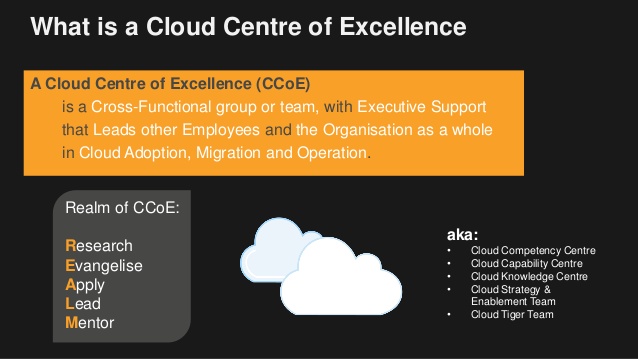
For Very Large Enterprises, it is unlikely that you will succeed at Cloud, without a centralised method, set of processes, standards, best practices and control. You will end up with sprawl, uncontrolled costs, configuration drift and no standard approaches to deployments. How best to control the chaos that can become Cloud? Have a Cloud Environmental Strategy based on a Centre of Excellence, or whatever name is appropriate, which will show the organisation best practices and control all environmental deployments, tool selection, platform selection, integration and security processes.
How to do this? Set up a Pod of SMEs (subject matter experts) into a team, for that particular Cloud Platform eg. AWS. All Cloud platforms are different. There is no ‘Cloud Team’. There should be Cloud teams – AWS, Azure, Google, Bluemix, SAP, Oracle. The SMEs are an agile team, cross-functional and includes business owners.
Apptio (who make Cloudability, a tool to control Cloud costs), blog post on why a COE is necessary.
https://www.apptio.com/blog/ultimate-cloud-center-excellence-ccoe-framework/
“At the heart of [a cloud migration strategy] you need to have someone who is an absolute expert on taking your workloads to the cloud because it’s not easy,” said Vijay Gopal, CIO, Shared Services, at Magellan Health, a $7B health benefits manager whose CCoE has been in place for three years. “Whether you call it CCoE or not, you have to get away from the white paper-based approach to actually have practitioners to guide you through it.”
Setting up a COE, from the Apptio blog post.
- Leadership: This would be a vice president level or equivalent who will help the group establish and maintain credibility as well as give it the authority it needs to function as a governing body. Ideally, the executive sponsor also will serve as a high-profile evangelist both for the cloud and the CCoE’s mission.
- Operations: You will need someone on your team that understands how the business functions so they can offer advice on things like application dependencies and how moving to the cloud will impact workflows, processes, and procedures.
- Infrastructure: This person will offer the lift-and-shift expertise you will need to figure out what cloud models will work for each scenario – IaaS, PaaS, SaaS, hybrid, private, and/or public. Ideally, they will know what infrastructure is currently being used to run which applications and store data and how transitioning to the cloud will change those dependencies.
- Security: Given that moving to the cloud will change how cybersecurity works at every application touchpoint from user authentication to networking, updating, and patching, someone needs to ensure that cybersecurity is baked into the cloud migration strategy from the beginning. Cybersecurity-as-an-afterthought is no longer an option today.
- Applications: Although moving to the cloud will impact everyone in your organization, the CCoE’s main constituency is your application developers. For that reason, someone who can represent the concerns and challenges of this unique group of individuals will be key to the success of your cloud migrations.
As the goal of a CCoE is to create repeatable frameworks and best practices for every function in an organization, CCoE members need to possess certain qualities, said Patel in a blog post for Amazon Web Services (AWS).